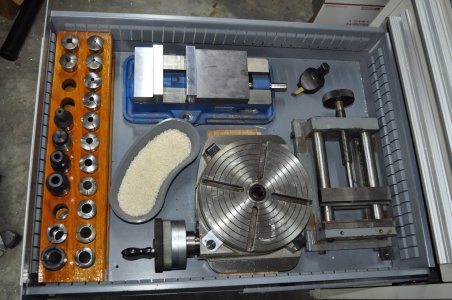- Joined
- Jan 16, 2016
- Messages
- 302
JUST THROWING THIS IDEA OUT THERE .
I HAVE HAD SOME RUST PROBLEMS WHEN THE RIGHT ATMOSPHERIC CONDITIONS COME MY WAY .
WATER WILL CONDENSE ON THE SHOP FLOOR & MANY METAL SURFACES .
THINGS THAT I THOUGH WERE SAFE CAN START RUSTING RIGHT INSIDE CABINETS .
I DO TRY TO KEEP THEM SPRAYED DOWN WITH FLUID FILM BUT YOU CAN'T CATCH EVERYTHING .
TOOLS HAVE NEVER RUSTED INSIDE MY GERSTHER BOXES BECAUSE THE WOOD ABSORBS THE HARMFUL MOISTURE .
I WAS WONDERING IF A LITTLE BIT OF RICE CAN HELP IN THE METAL CABINETS .
THE MOISTURE ABSORBING PROPERTIES OF DRIED RICE ARE WELL KNOWN .
I HAVE PLACED A FEW OPEN TRAYS OF RICE IN SOME OF THE CABINETS AS PART
OF MY CHEAPSKATE MOISTURE CONTROL SYSTEM . NOW WE WAIT FOR THE MICE .

I HAVE HAD SOME RUST PROBLEMS WHEN THE RIGHT ATMOSPHERIC CONDITIONS COME MY WAY .
WATER WILL CONDENSE ON THE SHOP FLOOR & MANY METAL SURFACES .
THINGS THAT I THOUGH WERE SAFE CAN START RUSTING RIGHT INSIDE CABINETS .
I DO TRY TO KEEP THEM SPRAYED DOWN WITH FLUID FILM BUT YOU CAN'T CATCH EVERYTHING .
TOOLS HAVE NEVER RUSTED INSIDE MY GERSTHER BOXES BECAUSE THE WOOD ABSORBS THE HARMFUL MOISTURE .
I WAS WONDERING IF A LITTLE BIT OF RICE CAN HELP IN THE METAL CABINETS .
THE MOISTURE ABSORBING PROPERTIES OF DRIED RICE ARE WELL KNOWN .
I HAVE PLACED A FEW OPEN TRAYS OF RICE IN SOME OF THE CABINETS AS PART
OF MY CHEAPSKATE MOISTURE CONTROL SYSTEM . NOW WE WAIT FOR THE MICE .


